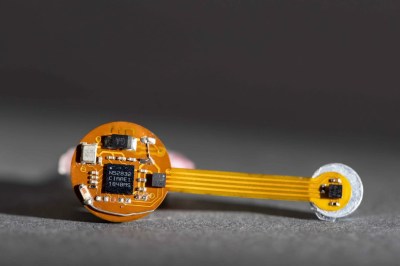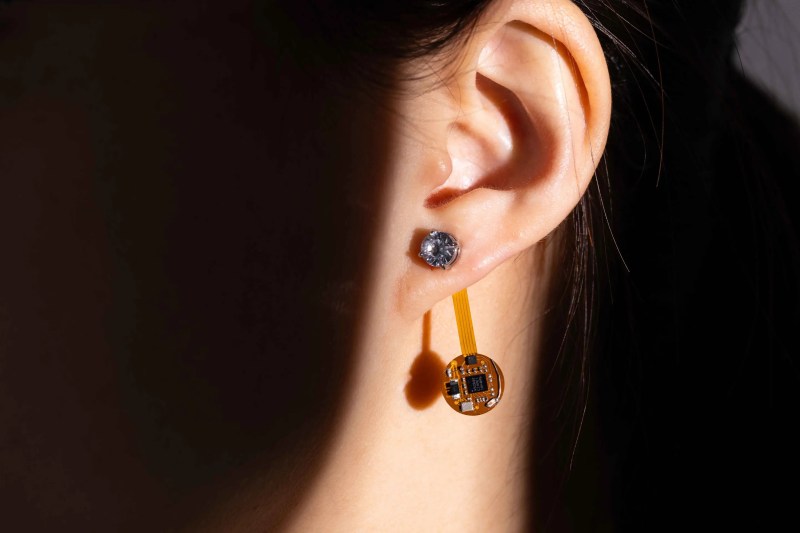If you want to constantly measure body temperature to track things like ovulation, you usually have to wear something around your wrist or finger in the form of a smartwatch or ring. Well, what if you can’t or don’t want to adorn yourself this way? Then there’s the thermal earring.
 Developed at the University of Washington, the thermal earring is quite small and unobtrusive compared to a smartwatch. Sure, it dangles, but that’s so it can measure ambient temperature for comparison’s sake.
Developed at the University of Washington, the thermal earring is quite small and unobtrusive compared to a smartwatch. Sure, it dangles, but that’s so it can measure ambient temperature for comparison’s sake.
You don’t even need to have pierced ears — the earring attaches to the lobe magnetically. And yeah, the earring can be decorated to hide the circuitry, but you know we would rock the bare boards.
The earring uses BLE to transmit readings throughout the day, and of course goes into sleep mode between transmissions to save power. Coincidentally, it runs for 28 days per charge, which is the length of the average menstrual cycle. While the earring at this time merely “shows promise” as a means of monitoring stress and ovulation, it did outperform a smartwatch at measuring skin temperature while the wearers were at rest.
This is definitely not the only pair of earrings we’ve got around here. These art deco earrings use flexible PCBs, and this pair will light up the night.
















Before Texas Instruments killed off TMP006 / TMP007 for obscure and probably legal reasons, one could also have made something more loose-fitting that would look into the ear canal.
How much would the ear lobe temperature be off when going outside in cold weather?
I imagine that is what the secondary ambient air temperature sensor is for.
Fudging miles off. My earlobes can be glowing hot while I’m freezing, or freezing cold while I’m roasting in bed, irrespective of the ambient. This is why doctors don’t measure temp via your earlobes, they use areas with high blood flow and low convective loss.
What battery does it use?
Also interested
Always looking for smaller and smaller batteries
From the paper, they used a 5.5 mAh Seiko MS621FE lithium manganese battery which sits behind the larger circle which dangles down. They note that this normally delivers 3V @ 15uA, which isn’t enough to boot the nRF53832 or transmit, so they’ve got a 100uF capacitor which charges when the board is in sleep and then buffers the current draw when it is active. They reckon the 28-day life of the device is when transmitting data every 10 seconds, which doesn’t seem so bad.
Sorry, should have said: the battery’s “standard discharge” current is 15uA, but it can continuously discharge 0.25mA at most. Still not enough for the nRF, hence the capacitor.
Thanks! That’s impressively low-power!
I have doubt about the usability because this kind of skin surface has low blood flow and close to the environment therefore the temperature can be whatever in a wide range. Maybe you can use it to detect/early warning frosting/burning and that’s all.
The blood flow to earlobe is actually quite high compared to a lot of other tissue. It’s a good place for a pulse odometer because of that. if the flow was low your earlobe would freeze off pretty quickly in cold weather due to its small mass.
.
But as to your point it’s not awesome for temperature for the same reason. But I do suspect, taken as a pattern over days then months you would have enough of a data set to reliably detect sub-1 degree changes on a day-to-hours timescale. Plus it’s fun and cool. (Punz!)
The amount of noise in the data likely drowns out the signal unless significant processing is done on it. The device itself doesn’t have to do that, but the paired device will. Interesting novelty.
The “at rest” reference intrigues me, as it’s quite a specific single scenario. Often that kind of reference indicates it’s the only scenario that showed success.